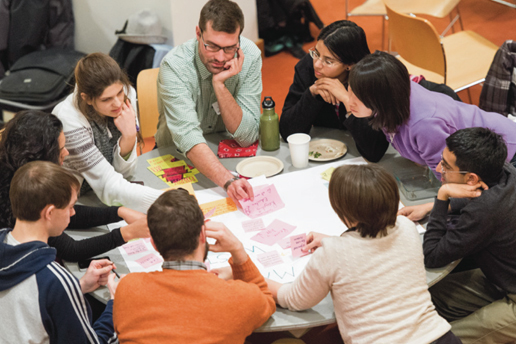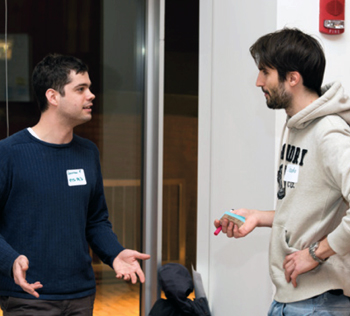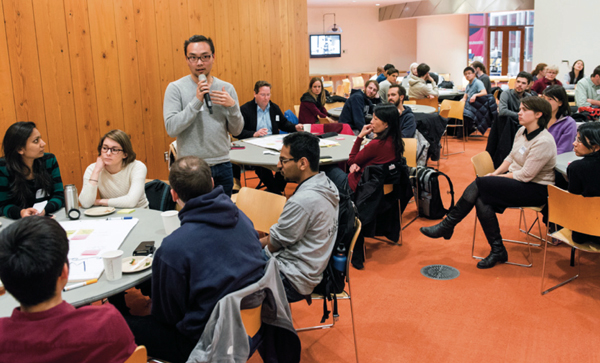
With nothing but sticky notes and poster boards, MIT students at a three-hour brainstorming session this winter designed and launched six new campus sustainability projects—taking on challenges ranging from composting to carbon emissions.
The MIT Generator event held February 26, 2014, brought nearly 40 students together with MIT facilities and sustainability staff to find practical ways to advance the Institute’s goals of integrating sustainability into all facets of operations.
“I thought it was amazing—a very MIT way to solve problems,” said Jonathan Krones SB ’07, a PhD student in the Engineering Systems Division (ESD), and president of Sustainability@MIT (newly renamed the MIT Sustainability Club), which organized the event along with the MIT Energy Club and the MIT Water Club. “Student projects are a powerful step toward culture change at the Institute.”
Students first heard a short presentation on MIT’s Office of Sustainability by Director Julie Newman, then quickly got to work exploring their own ideas for improving sustainability in seven categories: energy and climate; food; materials and waste; water; community building; transportation; and other.
Simon Choong, PhD student in chemical engineering and strategic advisor to the MIT Water Club, proposed working to rid the campus of bottled water to cut waste. Caroline Howe, an MCP student in urban studies and planning, advocated for more composting in dorms. The co-chair of the Graduate Student Council’s Sustainability Subcommittee, Howe also expressed interest in finding ways to reduce the amount of furniture discarded each year by off-campus students.

As the MIT Generator gets under way, organizer Jonathan Krones, left, discusses the plan for the evening with Claudio Hail, a graduate student in mechanical engineering. Photo: Justin Knight
ICF-MIT Energy Fellow Michael Davidson, a master’s degree candidate in ESD’s Technology and Policy Program, said simply: “I’m looking for the biggest bang for the buck on campus.” Davidson, whose research centers on modeling renewables integration into the power grid, said he hopes to see MIT provide more comprehensive data on energy use so that students can search for efficiency improvements.
Working at tables arranged by category, the students first developed project ideas in real time to present to the group as a whole. Then participants were invited to team up to pursue endeavors of interest to them. Newman was on hand to provide expert advice, as were Steven Lanou, deputy director of the Office of Sustainability, Peter Cooper, manager of sustainable engineering and utility planning at MIT Facilities, and Ruth T. Davis, manager for communications and sustainability at MIT Facilities.
By the end of the evening, the students had formed six project teams, each with its own action plan. They were:
- MIT energy data “hackathon”— working with MIT Facilities to make data on energy and water use in MIT buildings more accessible via a data challenge or hackathon.
- Green catering—teaming with purchasers and caterers to reduce the packaging waste generated by catering at MIT, starting with the MIT Sloan School of Management.
- Tech trash—improving campus waste bin labeling and signage to increase the amount of waste that is either recycled or composted.
- Storm water reuse—investigating the feasibility of capturing storm water and using it for cooling in the MIT Cogeneration Plant.
- Tonnes matching—using a “matching gift” program model, this project would ask members of the MIT community to reduce their own greenhouse gas emissions, with MIT pledging to match those reductions.
- Sustainability mixers—organizing monthly get-togethers for those interested in issues of sustainability and providing continued support for the community-building effort begun at the Generator.
Each team was then charged with creating a plan for the semester, identifying funding needs and sources, and finding project partners in the administration and faculty. Teams that made significant progress were invited to share their work with the MIT community and the broader professional sustainability community at the sixth annual MIT Sustainability Summit (sustainabilitysummit.mit.edu), which took place May 3–4 at the MIT Media Lab.
A history of service to MIT
The MIT Generator was first held in 2006—the same year the Institute launched the MIT Energy Initiative—and was organized by two PhD students who have since joined the MIT faculty— Jason Jay PhD ’10, a lecturer in the MIT Sloan School of Management, and Elsa Olivetti PhD ’07, an assistant professor of materials science and engineering.
Over the years, several useful projects have emerged from the event, including an effort to turn waste cooking oil into biodiesel fuel, a campaign to turn off lights, and a map of campus energy use. “Students often challenge us to look at existing problems in new and innovative ways,” Lanou said. “The energy map is an example: It presents information in a way that literally illuminates the challenge with glowing red buildings.”
Krones, who participated in the inaugural MIT Generator as an undergraduate, said he thought the time was ripe to reprise the event, last held in 2011. “Since coming back to MIT, I have seen student interest in topics of sustainability on a sharp rise. … At the same time, we’ve had institutional changes around this topic—for example, the new Office of Sustainability, which is a really magnificent step by the administration and a very real commitment to establishing MIT as a leader in sustainability.”
The Generator received support from the MIT Energy Initiative, the MIT Office of Sustainability, and the Sustainability Initiative at MIT Sloan.

Simon Choong, PhD student in chemical engineering, shares ideas from his small group’s discussion on water conservation with other participants at the MIT Generator. Photo: Justin Knight
This article appears in the Spring 2014 issue of Energy Futures.